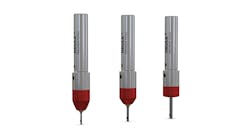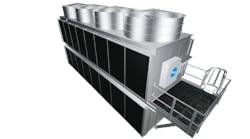Rapid Opening Closures Revolutionize Pipeline Servicing
Many pipeline launchers and receivers in the 1960s used flanged entry technology—de-pressurizing and opening a pressurized pipeline for cleaning and inspection— that resulted in hours of effort by multiple operators (or days for large gas filtration vessels). The introduction of pressure vessel closures was an improvement over this prior technology, which enabled access with slightly more ease.
However, not all closures are created equal. Slow and challenging to operate, bolted clamp and threaded type closure designs aren’t the only closure technology available on the pipeline market. Rapid-opening closures, whose designs have been honed and improved over the past two decades or so, can simplify the opening process such that a single operator can safely and quickly open a pipeline door in minutes, without any special tools. This technology simplifies maintenance activities, reduces the number of field operators, and is a simpler, safer, cleaner, and easier-to-use alternative than traditional techniques.
Particularly in applications where frequent access is necessary, or where larger pipelines or pressure vessels are in use, makes traditional closure systems prohibitively large and heavy, eliminating downtime while improving ease and safety over traditional methods—offering significant benefits of efficiency and cost.
Pitfalls of Traditional Designs
Bolted blind flanges, as well as clamp and threaded type closures, were the standard acceptable technology for pipelines and pressure vessel closures for many decades. However, the demand for increased pipeline inspections and the change out of filters has increased opening and closing frequency. Consequently, the speed of access to reduce downtime has become a critical focus.
What’s more, many of these traditional designs of pipeline closures feature external locking mechanisms and safety elements that are exposed to the weather and harsh exterior environments. These aggressive conditions can increase both the danger and the difficulty of opening traditional closure designs.
Finally, traditional closures are typically designed to standard flange pressure class ratings; Class 600, 900, 1500, and 2500 respectively. However, pressure vessels are not always designed to the same standard class ratings, and so discrepancies may result in pipeline closures that are far heavier and more expensive than is necessary. For example, if a pressure vessel is designed to an intermediate Class 1200, a standard full class 1500 closure would be used, which would be heavier and more expensive than required.
Technology to Improve Safety and Efficiency
Rapid opening closures (ROCs) for pipelines and pressure vessels were designed to eliminate the challenges of efficiency and safety posed by more traditional closure designs. These ROCs are manufactured to the same design code as traditional ones (e.g., ASME Section VIII-Division 1), but incorporate improved safety features such as pressure warning interlocks and fail-safe design measures. Furthermore, these safety features are designed in a way that still enables far faster access, with fewer operators than traditional designs.
Take, for example, the rapid opening closures manufactured by CIRCOR Pipeline Engineering. These closures can be opened by a single operator in less than one minute, without any special hand tools. In addition to the speed and ease of operation, the CIRCOR ROCs also incorporate the required safety mechanisms to prevent the operator from opening the closure when residual pressure is present. With CIRCOR’s ROC, the actual pressure warning feature and mechanical interlock device are one and the same. The pressure warning indicator mechanically interlocks with the drive plate mechanism to prevent the closure from being opened. Thus, by combining these separate safety elements into a single component, the CIRCOR closure meets all critical safety standards but also avoids the time-consuming operation of separate stand-alone elements.
The CIRCOR ROC features fail-safe technology that ensures the failure of any single closure component will result in it failing to a secured closed position. What’s more, these mechanisms are housed within the closure door itself and are protected from the harsh environments of both the exterior and interior of the pipeline.
This particular ROC also features a recessed self-energized lip seal, which requires no mechanical force to close and seal and far less frequent changes than compression O-ring type seals. As the internal pipeline pressure increases, the flexible lip seal energizes and forms a pressure-tight seal between the closure hub and door. Furthermore, given that the self-energizing lip seals can last months or years before requiring replacement compared with O-rings that can survive only a single opening cycle, the total cost of ownership is also lower.
Benefits in Diverse Applications
Rapid opening closures deliver significant benefits over traditional designs across a wide range of applications, from oil and gas pipelines to filtration or separation pressure vessels, sour-service (H2S) or high-corrosion conditions (saltwater & brine). The more frequently these pipelines or pressure vessels must be cleaned, inspected or serviced, the more worthwhile a ROC becomes. Given that ROCs can eliminate multiple days of downtime and, as in the case of the CIRCOR ROC, reduce the required personnel for that servicing, even pipelines and vessels that must be opened once every quarter can see a rapid ROI.
Even more critically important than ease of operation and low time to open and close is the safety ensured by ROCs like those manufactured by CIRCOR. In high-pressure pressure vessels and pipelines, safety is both critically important and challenging to achieve. The safety features inherent in CIRCOR’s ROC design deliver significantly higher peace of mind than traditional options, even while also reducing the number of operators needed.
Learn more about CIRCOR's Rapid Opening Closure
A final benefit of CIRCOR’s ROCs, most evident in pressure vessel applications where large and high-pressure pipelines are in use, is the ability to design the closure to each individual application’s parameters of size, pressure, temperature, and more without sacrificing the unique ease of operation. One person can operate closures of up to 72-in. in diameter, and that closure can be ideally suited to its particular application. This is in direct contrast with the challenge, described above, in having to size traditional closures to the closest safe pressure class, even if that means added weight and cost. CIRCOR can design its closures to suit specific design pressures intermediate to traditional flange classes, making them less expensive and lighter in many applications. What’s more, in applications like offshore pipelines where weight is critical, the weight of the closure can be minimized while retaining essential safety measures.
Conclusion
As rapid opening closures have been developed over the past two decades, their superior design over traditional pipeline and pressure vessel closures has become more and more evident. Capable of maintaining and even improving safety while significantly reducing working hours and downtime needed to service pipelines, ROCs can be a significant source of cost savings over the lifetime of an asset.











